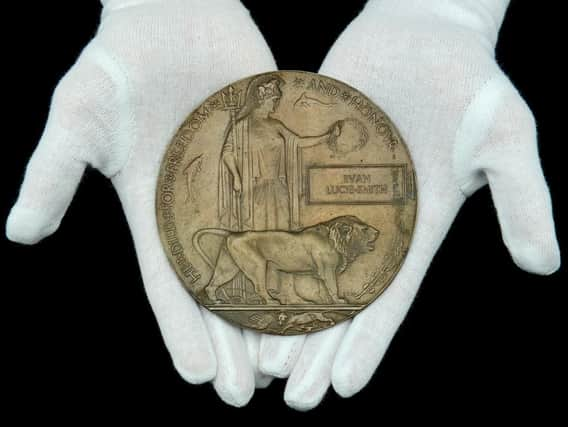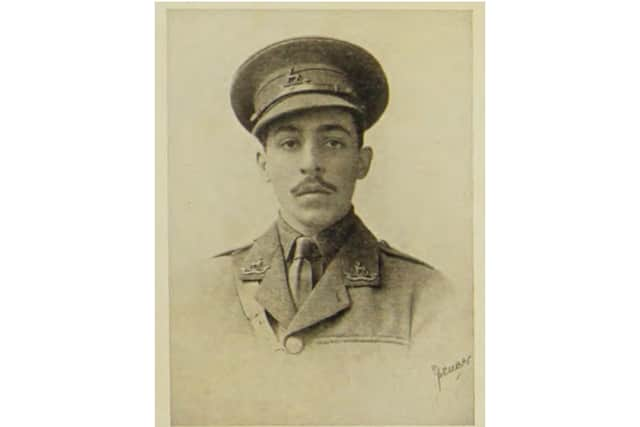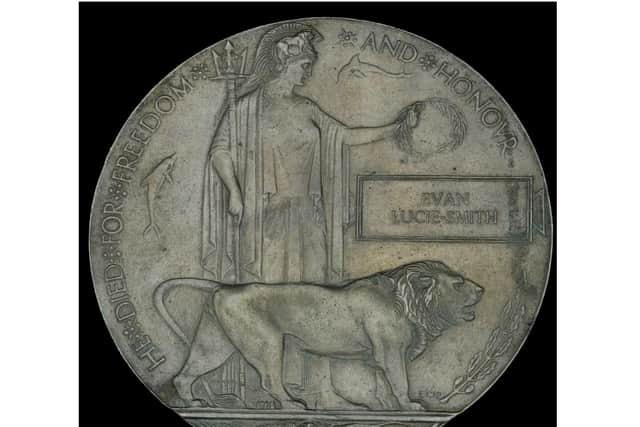Memorial plaque for WW1's first black officer who was in Royal Warwickshire Regiment to go to auction


A memorial plaque for a member of the Royal Warwickshire Regiment who is believed to have been World War One's first black officer will be going up for auction.
Lieutenant Euan Lucie-Smith, 1st Battalion, Royal Warwickshire Regiment, is believed to have been the first black officer commissioned into a British army regiment during the Great War and is also believed to have been the first Black officer casualty of the war, when he was killed in action on April 25, 1915, at the Second Battle of Ypres.
Advertisement
Hide AdAdvertisement
Hide AdThe plaque will be offered by Dix Noonan Webb in its online auction of Orders, Decorations, Medals and Militaria on Thursday, November 12.


It has been estimated at £600 to £800.
Being related to the Royal Warwickshire Regiment, the team at the Fusiliers Museum in Warwick are interested in the item.
A spokesperson from the Fusiliers Museum in Warwick said: " We are interested in acquiring it for our museum; it would be a unique and memorable piece and is further evidence of members of The Commonwealth serving in The Royal Warwickshire Regiment during the First Great War.
"This is a unique plaque that tells a really important story about the first black officer to be commissioned, serve and sadly die in the British Army in World War One.


Advertisement
Hide AdAdvertisement
Hide Ad"It shows the invaluable contribution made by the Commonwealth countries."
The plaque was discovered by former Member of the European Parliament, James Carver, who is a keen collector of medals relating to West African soldiers of the Victorian and Edwardian era.
He spotted it for sale on the open market, bought it on a hunch, and since researched Lieutenant Lucie-Smith’s military career and family background.
He said: "Until now, the best-known black soldier of World War One has been Walter Tull, however I now believe Lucie-Smith to be the first black officer.
Advertisement
Hide AdAdvertisement
Hide Ad"His background was quite different to Tull’s – coming from a privileged Jamaican family, he was undoubtedly from the so-called “Officer Class”, having attended two English Private Schools.”
Christopher Mellor-Hill, head of client laison and associate director of Dix, Noonan, Webb, said: “We are delighted to be offering this Memorial Plaque and celebrating then career of Euan Lucie-Smith.
"Much has been written about Walter Tull, who was till now erroneously assumed to have been, (and regularly referred to), as the first black officer commissioned into a British army regiment during the Great War, (on May 30, 1917) and the first black officer casualty of the Great War, when he was killed in action during the First Battle of Bapaume on March 8, 1918.”
“But now we have Euan Lucie-Smith, who was not only the first black officer commissioned into the British army, but was also the first black officer killed in action some three years before Walter Tull was.”
Advertisement
Hide AdAdvertisement
Hide AdCustomers are able to bid live online or leave commission bids prior to the auction.
For more information go to: https://www.dnw.co.uk/More information about Lieutenant Euan Lucie-Smith
Like Walter Tull, Euan Lucie-Smith hailed from a mixed heritage background.
He was born at Crossroads, St. Andrew, Jamaica, on December 14, 1889 to John Barkley Lucie-Smith, (the Postmaster of Jamaica), and Catherine “Katie” Lucie-Smith (nee Peynado Burke).
Advertisement
Hide AdAdvertisement
Hide AdHis father hailed from a line of distinguished white colonial civil servants. His mother was a daughter of the distinguished “coloured” lawyer and politician Samuel Constantine Burke, who campaigned for Jamaican constitutional reform in the late 19th century through his desire for Jamaica to have greater control over her own affairs than Whitehall.
His advocacy on behalf of both the black and “coloured” populations of Jamaica, helped create a reputation that even led him to later be referred to, by name, in an essay of the renowned Black activist, Marcus Garvey.
Euan Lucie-Smith was educated in England, initially at Berkhamsted School, before Eastbourne College, (His address during his Great War service is noted as Berkhamsted School).
Returning to Jamaica, he was commissioned into the Jamaica Artillery Militia on November 10, 1911.
Advertisement
Hide AdAdvertisement
Hide AdHe appears as a Lieutenant in a later, pre-war, Forces of the Overseas and Dominions list.
Just six weeks after the outbreak of war, he was commissioned as a Second Lieutenant into the regular force of the Royal Warwickshire Regiment, appearing in the supplement to the London Gazette of November 30, 1914: “Dated September 17, 1914, The undermentioned candidates from the self-governing Dominions and Crown Colonies to be Second Lieutenants. – Euan Lucie-Smith, Royal Warwickshire Regiment....”.
Believed to have been the only name on this list from the Caribbean, or East and West Africa, he appears as the first of fourteen names, giving him seniority above the other men also commissioned from Australia, Canada, India, South Africa and New Zealand. (Confirmation that he was commissioned two years and eight months before Walter Tull).
He landed in France on March 17, 1915, and, just over a month later, although initially reported as missing, he was later confirmed as being killed in action on April 25 1915, aged 25, during the Second Battle of Ypres. (Becoming a casualty two years and eleven months before Walter Tull).
Advertisement
Hide AdAdvertisement
Hide AdA statement made by a Pte. F. Jukes, at Suffolk Hall Hospital, Cheltenham, stated “Lieut. Lucie-Smith - Was told by his servant that he was killed, and had seen him dead. Shot through the head”.
He has no known grave and is commemorated on Panel 2 to 3 of the Ploegsteert Memorial, Belgium.
He is also commemorated on the Berkhamsted School Memorial, the Eastbourne College Memorial and has an entry in “Jamaica in the Great War”.